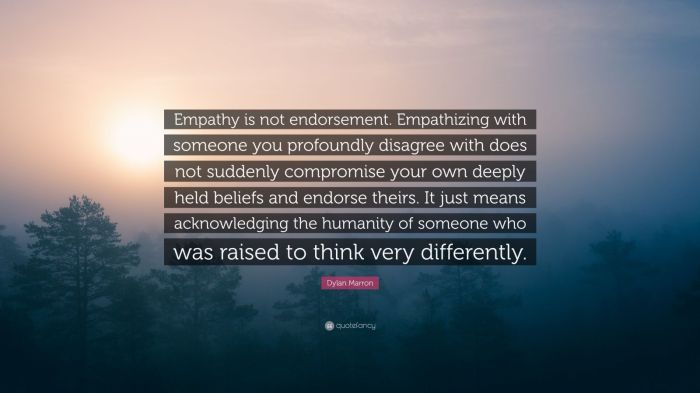Empathizing with others requires agreeing with them. – Empathizing with others requires agreeing with them, or so the misconception goes. This assumption overlooks the nuances of empathy and its role in effective communication. Empathy involves understanding and sharing the feelings, thoughts, and experiences of another person, even if we don’t necessarily agree with their perspective.
To truly empathize, we must practice perspective-taking, active listening, and emotional regulation. These skills allow us to step into another’s shoes, comprehend their viewpoint, and respond with compassion, even when our own opinions differ.
Understanding the Nature of Empathy

Empathy is the capacity to understand and share the feelings, thoughts, and experiences of another person. It involves stepping into someone else’s shoes and seeing the world from their perspective. Unlike sympathy, which is a feeling of pity or compassion, empathy requires an active cognitive and emotional engagement.
Perspective-taking is a crucial aspect of empathy. It involves imagining oneself in another person’s situation and trying to understand their thoughts, feelings, and motivations.
The Importance of Empathy in Communication
Empathy enhances communication effectiveness by fostering understanding, rapport, and trust. When people feel understood, they are more likely to open up and share their thoughts and feelings. Empathy can help build rapport by creating a sense of connection and commonality.
In conflict resolution, empathy can play a significant role in de-escalating tensions and facilitating productive dialogue. By understanding the perspectives and emotions of all parties involved, it becomes easier to find mutually acceptable solutions.
Strategies for Developing Empathy

Practicing perspective-taking is essential for developing empathy. This can be done through role-playing, simulations, or simply imagining oneself in different situations.
Active listening is another key strategy. By paying attention to both verbal and nonverbal cues, one can gain a deeper understanding of another person’s feelings and experiences.
Emotional regulation is also important. When one is overwhelmed by their own emotions, it can be difficult to empathize with others. Techniques such as mindfulness and deep breathing can help manage emotions and foster a more empathetic mindset.
Misconceptions about Empathy: Empathizing With Others Requires Agreeing With Them.

One common misconception is that empathy requires agreeing with others. While understanding someone’s perspective is important, it does not mean condoning or supporting their actions or beliefs.
Empathy also has its limits. There may be situations where it is not possible or appropriate to empathize, such as when dealing with extreme violence or abuse.
Disagreeing with someone can be done respectfully by acknowledging their perspective, expressing one’s own perspective, and finding common ground.
Empathy in Different Contexts
Empathy plays a vital role in personal relationships. It fosters understanding, intimacy, and support. In professional settings, empathy can enhance communication, build trust, and improve collaboration.
Empathizing with people from diverse backgrounds can be challenging, but it is essential for creating inclusive and equitable environments. It involves recognizing and respecting differences while seeking common ground and shared experiences.
FAQ Guide
Is empathy always about agreeing with others?
No, empathy involves understanding and sharing another’s feelings, even if we don’t agree with their perspective.
How can we develop empathy?
By practicing perspective-taking, active listening, and emotional regulation.
What are the benefits of empathy?
Enhanced communication, improved relationships, and more effective conflict resolution.